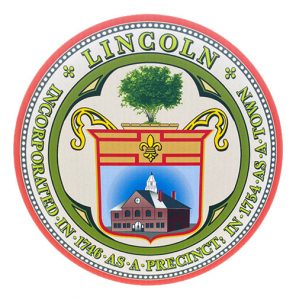 Residents heard updates on electricity aggregation, road safety measures, and planning for South Lincoln’s future at the third State of the Town meeting on November 19.
Residents heard updates on electricity aggregation, road safety measures, and planning for South Lincoln’s future at the third State of the Town meeting on November 19.
Electricity from renewable sources
Almost three years after voters authorized the Board of Selectmen to start developing the program, the Green Energy Committee is nearing the finish line for Lincoln Green Energy Choice, a program that will give residents the option of buying electricity from renewable sources. Eversource will continue to provide transmissions lines and billing, but the town will seek bids for renewable energy from the local grid. Committee chair C.J. Volpone explained that residents can opt in or out of the program at any time, though they will be automatically enrolled initially in a plan that will cost about the same as Eversource’s winter rates.
Eversource is currently required to draw 18% of its electricity from renewable sources. The new program will offer three options:
- Budget, with 20% of the electricity from renewable sources
- Basic Green, with 35-50% renewable (the default option that residents will be enrolled in unless they opt out)
- Total Green, with 100% of the electricity from renewable sources. Volpone said this option would probably cost $20–$30 a month more than the current average bill, though the exact price won’t be known until buds are received and a contact is signed.
LGEC has posted a table showing preliminary estimates of additional costs depending on type and amount of electricity usage.
Benefits of the program include reducing greenhouse gas emissions, having a choice of electricity sources, and having long-term predictable rates for electricity, since LGEC contracts will be longer than the six-month contacts required of Eversource, Volpone said. Using electricity from renewable sources will become more important in the years to come as more and more people buy electric cars and use electric-power heat pumps for home heating, he added.
Homeowners will get a postcard in the mail informing them of the options and asking if they want to opt out before the program launches, which is expected to happen in March 2021, Volpone said. Resident Sara Mattes (one of 118 people who attended the online meeting) worried that there could be “blowback” because people will be automatically enrolled in the program, but Volpone said the impact on electric bills for the Basic Green option would be “minimal.”
Advisory shoulders
Bob Wolf and Ginger Reiner of the Bicycle and Pedestrian Advisory Committee (BPEC) outlined a method that could be used to make Lincoln’s roads safer for bikes and walkers. Advisory shoulders are lanes marked with white dashed lines on either side of a road to indicate where bikes and pedestrians have the right of way. Vehicles can cross the lines to avoid traffic coming from the opposite direction but must yield to oncoming traffic if there are “vulnerable users” (bicyclists, pedestrians, or any other non-vehicle) ahead or alongside.
The committee and its predecessor, the Cycling Safety Advisory Committee, came into being after two bicyclists were killed and a third was injured in three separate accidents on Lincoln roads in 2016. More than half of the residents who responded to a subsequent town-wide survey said they were not comfortable biking or walking on some of Lincoln’s roads.
As a road safety measure, advisory shoulders have the advantage that they are inexpensive and easy to create. “It doesn’t change how the road should be used, but it shows the clearance that vehicles should give vulnerable users,” Wolf said. In other towns such as Hanover, N.H., that have tried this approach, “drivers get used to this pretty quickly.”
The BPAC studied Baker Bridge Road as a possible first case where advisory shoulders could be installed. As one of several designated “minor connectors” in town, the road offers connections to schools and access to conservation trails. In a neighborhood Zoom meeting with the BPAC in October, there was “universal agreement” among Baker Bridge Road residents that the road is not safe for pedestrians and family cycling.
Wolf acknowledged that “it’s not one size fits all for all Lincoln roads” and invited residents of other neighborhoods to set up a Zoom meeting with the committee to discuss safety issues by emailing lincoln-bpac@googlegroups.com.
South Lincoln
The South Lincoln Planning and Advisory Committee (SLPAC) has “restarted the process to evolve our village center” to make it more vibrant for residents and businesses, Planning Board chair Margaret Olson said. Businesses in the area have been struggling for some time, and a “confusing and costly” permitting process on top of a “hodgepodge” of five different zoning districts has made it very difficult for any sort of new development to win approval.
Revamping the zoning rules in South Lincoln would offer more flexibility in building uses, a more diversified housing stock, and a clearer permitting process while still imposing design guidelines to ensure new development is in keeping with Lincoln’s “look” and character, Olson said. SLPAC and the Planning Board will “build consensus… around an open and transparent process” with broad public participation and input. As part of that goal, the committee is inviting public comment any time and posting letters from residents on its website.
As part of the larger goal to limit climate change, the town hopes to encourage use of the commuter rail stop as well as energy-efficient buildings and more usage by bikes and pedestrians. The state also wants to encourage more use of mass transit. For example, Massachusetts House Bill 3931 would require multifamily zoning within one mile of train subway and bus stops.
While that particular bill may not pass, “there is pressure mounting in the system for something along these lines,” Olson said. “When regional problems get too big, the dam breaks, and 40B [the affordable housing mandate] is an example of that. We need to indicate how we want the town to change and adapt to the political and environmental changes headed our way in the next few decades.”
SLPAC’s predecessor tried to bring zoning changes to a town-wide vote last year but met with stiff opposition from residents who, among other things, were worried that residents in midrange housing such as the Ridge Road condominiums would be displaced. “SLPAC has heard that loud and clear,” Olson said, adding that near-term rezoning efforts will focus only on the south side of Lincoln Road.
The need for action is not hypothetical. The privately owned sewage treatment system used by Lincoln Woods and the mall is past its useful life, and the town plans to commission a study of options for upgrading and expanding it or else finding some other solution to allow more development.
Another reason for rethinking the South Lincoln commercial area: the mall itself will not be economically viable for much longer. Michelle Barnes, chair of the Rural Land Foundation (which owns the mall) reiterated her statement from last spring that changes in shopping habits are making it increasingly difficult for stores to succeed.
“I’m trying not to say anything about our current collection of enterprises, but I think it’s fair to say that over time, year after year, we have seen a decline in business at the mall,” Barnes said at the SOTT meeting. “Thinking about what’s going on economically elsewhere with local malls, they just have not been surviving, and certainly not thriving. The longer-term trends don’t look that great and we feel we have to be proactive in making sure it stays a vibrant place.”
The RLF operates the mall as a nonprofit, Barnes noted. “As economic forces on the mall continue to go in one direction, the fact that we don’t have much margin makes that endpoint collide eventually. That’s not tomorrow, but the long-term sustainability of the mall in its current state is not tenable.”

This is an excellent summary of Lincoln Green Energy Choice. Thanks for writing this, Alice.
Re Green Energy, readers should be aware that we can ALREADY CHOOSE among DOZENS of alternative energy suppliers, many of them entirely green, by simply going to the Commonwealth’s webpage that lists our choices in a handy, common sense manner.
https://www.energyswitchma.gov/#/compare/2/1/01773//
The one apparent difference in what the Green Energy Committee is proposing is that their choice of a green energy provider would become our default provider rather than Eversource being our default provider. If that happens, we should all be aware that our choice would not be merely between the Committee’s choice and Eversource, but among the DOZENS of alternative providers that are already available to us through the Commonwealth’s program that has been in place for several years now.
Glad to be able to remind Lincolners that they don’t have to wait until March to choose an alternative electricity provider! Ned Young.
However, readers should be aware that for some of those alternative providers, the implied environmental benefits of buying their “renewable” power are illusory. For example, several years ago I naively signed up with Clean Choice Energy. Turns out, their wind energy is renewable energy credits generated by Texas wind farms, and multiple experts have since advised me that buying those credits has no real-world effect on the amount of renewable energy generated or capacity built. In contrast, the Lincoln Green Energy Choice program will be buying “Class 1” renewable energy credits, which actually do drive increases in renewable energy capacity and generation. So I would encourage anyone interested making doing something about climate change through reducing their carbon footprint to (A) stay in the Lincoln Green Energy Choice program and (B) opt up to the “100% Green” option if you can. In either case, you will be purchasing Class 1 renewable energy credits and thus driving the “greening” of the grid.
In addition to Paul’s reply, it’s also important to keep in mind that we’re leveraging our collective buying power with Lincoln Green Energy Choice. Not only is your investment in renewable energy locally sourced for real impact on emissions, but the LGEC represents pooled buying power and better negotiating leverage with suppliers.
CJ
While advisory lanes for walking and biking are an intriguing concept, many of the participants felt that Baker Bridge Road is not a good candidate because of all the perilous blind curves and that big rock that juts into the travel lane. Unless the site line problems are fixed, we will have to look for another solution for Baker Bridge Road.
All may be true.
We are still examining our current choice-we “opted in” CleanChoice which is 100% renewable energy, over a year ago.
It was our choice, not a default.
So, far, we have been very pleased.
My main concern is that many may not understand the “opt out” choice and find themselves with higher bills.
Again, I would urge the Green Energy Committee to present us with an “opt in” action.
That is a positive approach and will catch no one unawares.